| |
 |
Oberlin |
Ohio |
USA |
Vertical Dial |
Dial 219 |
| Once, high on the physics building south wall was a student made vertical dial. The 5'x8.5' resin coated particle board made by Mark Kearns in 1979 had curved hour lines to account for the equation of time, declination of wall, and offset from standard meridian. This dial has not been on display for some time. Perhaps some student would create a new dial. The brick wall is an excellent location. |
| |
| |
 |
Washington |
District of Columbia |
USA |
Horizontal Dial |
Dial 218 |
| Horizontal dial 12 in. square designed and built by David Shayt and David Todd of the Smithsonian Institution. Roman numerals, 5AM-7PM. Subdivided into 15 minute increments. Also has compass rose. Dial sits atop a rectangular granite pedestal. |
| |
| |
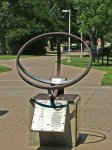 |
La Crosse |
Wisconsin |
USA |
Equatorial Dial |
Dial 217 |
| A 40 inch diameter armillary on a 2 foot tall cement cubic base. The original analemma-shaped gnomon was missing and replaced with a section of loose ordinary electric wire. Includes a longitude-correction plaque showing the corrections throughout 15 degrees longitude. Dial sits atop a 26 inch high, 26 inch square pedestal. Robert Allen states that this dial is a scaled down version of the one at the San Diego Zoological Garden, and that there is a similar one at Williams College in Williamstown MA. |
| |
| |
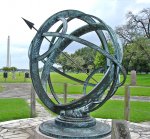 |
La Porte |
Texas |
USA |
Armillary Sphere |
Dial 216 |
| Approximately 6 foot diameter bronze armillary dial with equatorial, meridian and equinoctial colure rings and with Arctic and Antarctic circle rings. Hour lines have 5 minute marks and Roman numerals. Equatorial ring has Zodiacal signs. Base shows the Great Seal of Texas and includes a bronze eternal flame.
Names of fallen heroes are inscribed on the base and paths to and from the dial lead to location of Sam Houston's troops prior to the battle of San Jacinto. The San Jacinto Monument is seen in the distance. |
| |
| |
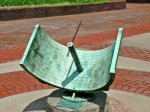 |
New York |
New York |
USA |
Cylindrical Dial |
Dial 215 |
| A half-cylinder equatorial dial whose body structure is exactly the same as the one (#28) at Trinity College, Hartford, CT, only the pedestal here is lower. Named ?The Camp Columbia Sundial?, a gift of Camp Columbia to memorialize Dean Hennessy (1917-1991). |
| |
| |
 |
El Cajon |
California |
USA |
Armillary Sphere |
Dial 214 |
| Armillary dial about 3 ft. diameter designed by Don LeGrande. As of Christmas 1992, a stunning armillary sphere-type of sundial ... The framework of the dial is constructed of burnished stainless steel. ... The rod-like gnomon was destroyed by vandals many years ago, but the rest is in good shape. |
| |
| |
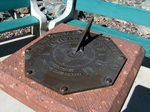 |
San Diego |
California |
USA |
Horizontal Dial |
Dial 213 |
| This is not the Koester dial at SDSU, but a far more interesting horizontal dial originally dedicated to the San Diego Normal School for elementary teaching by the class of June, 1911. The 18-inch octagonal bronze dial was originally designed by San Diego Clock maker Joseph Jessop and mounted on a miniature Doric column. The dial was placed within the circular lawn directly in front of the school's main entrance at the intersection of Park and El Cajon Boulevards. |
| |
| |
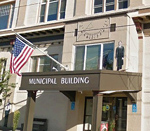 |
Anacortes |
Washington |
USA |
Vertical Dial |
Dial 212 |
| A vertical dial 4 x 8 feet on marine plywood painted the same color as the building. An aluminum rod gnomon casts the shadow, supported by a copper strut of plumbing pipe. Early photos show dial with no hour lines. By 2017, short hour and half hour lines added near the Arabic hour marks. Both form a semicircle around the gnomon, telling time from 7am to 6pm. |
| |
| |
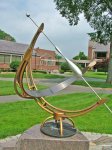 |
Windsor |
Connecticut |
USA |
Equatorial Dial |
Dial 211 |
| Equatorial dial about 5 ft. diameter made of brass and stainless steel The analemma is incorporated into the gnomon compensating for equation of time. Equatorial ring is rotated to compensate for difference in longitude to time zone. Designed and built by Physics/Astor Dept, University of Calgary, Alberta Canada. Dial sits atop a stone plinth marked with Keller's laws. |
| |
| |
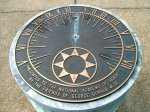 |
Washington |
District of Columbia |
USA |
Horizontal Dial |
Dial 210 |
| Circular horizontal dial 20 in. diameter cast in bronze. Has Roman numerals at hours and 15 minute marks. Gnomon missing from dial, but kept by groundskeeper, as it will not stay in place. Was temporarily re-installed for the NASS tour in 1995. The dial is modern, honoring George Donald Meid for service to the National Academy. Dial is mounted atop a concrerte cylindrical post. |
| |
| |
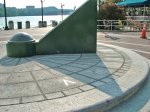 |
Washington |
District of Columbia |
USA |
Horizontal Dial |
Dial 208 |
| Large, ground level horizontal dial 16 ft. in diameter with 49 in high stepped hollow painted-green metal gnomon that is 5 ft 16 in long. Roman hour numerals with hour lines from 4:30 AM to 9:30 PM. Gnomon structure recalls the much larger Indian observatory dials. An appropriate poetic passage, once bolted to the gnomon, has disappeared. |
| |
| |
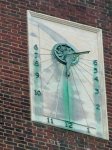 |
Washington |
District of Columbia |
USA |
Vertical Dial |
Dial 207 |
| Vertical bronze dial with Arabic numerals and long cast sunburst gnomon. On oblong sandstone. Dial is 60-80 feet up on an octagonal power plant smokestack. It is difficult to read, but safe from vandalism. School dated 1928. Similar to Eastern High School (#202). |
| |
| |
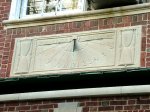 |
Washington |
District of Columbia |
USA |
Vertical Dial |
Dial 206 |
| Sandstone Vertical declining dial, with gnomon offset to account for it. Above doors to rear terrace of admissions building. Arabic hour numerals with half hour lines. Carved hourglasses on both sides frame the dial. Brass compass rose set into the brick terrace below suggests the general alignment of both house and dial. |
| |
| |
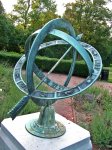 |
Washington |
District of Columbia |
USA |
Armillary Sphere |
Dial 205 |
| Very nicely armillary sphere about 3 ft. diameter, with equatorial, meridional and hour circles. Roman hour numerals from 5 AM to 7 PM. One of Washington DC's cleanest examples of a working armillary sphere. Erected by the Georgetown Garden Club in 1956 in tribute to Sarah Louisa Rittenhouse. Dial is placed atop a sandstone pillar. |
| |
| |
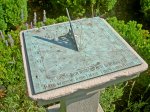 |
Washington |
District of Columbia |
USA |
Horizontal Dial |
Dial 204 |
| Horizontal dial about 16 inch square made of bronze. Gnomon is 4.125 inch high, 5 inch long. Below gnomon is motto, "Horas non numero nisi serenas" (I only count sunny hours). House was built in 1805 and is now open to the public as a museum. Years before this property was opened to the public, a family member brought this dial from Crossbasket Castle in Scotland, the family seat. The lengthy inscription is probably a later addition, since it is unlikely that they would be quoting Whittier in Scotland. The gnomon angle is 39? 30', probably made for the Washington DC location. However, the dial plate has a latitude of about 48? N, certainly not Scotland. What is the true origin of this dial? |
| |
| |
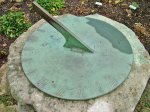 |
Washington |
District of Columbia |
USA |
Horizontal Dial |
Dial 203 |
| In the Bishop's garden is a weathered 13th C. capital on which sits a 41 cm diameter horizontal brass dial. It is engraved with "Tho Heath, London" and the year 1712. On the noon line is the indication "Hammersmith", a location on the (then) outskirts of London at 51:30N 0:14W. Heath is one of the Grocers' Company mathematical instrument makers Many of Heath's dials have a coat of arms. |
| |
| |
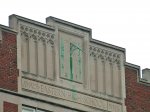 |
Washington |
District of Columbia |
USA |
Vertical Dial |
Dial 202 |
| Vertical dial with bronze Roman numerals and trefoil pierced gnomon on square sandstone. Dial is on south facade over main entry, facing East Capitol Street. School is dated 1923 and architect Snowden Ashford. Elevation above entrance is approximately 30 ft. making dial hard to read. Large projecting towers place dial in shadow in early morning and late afternoon. Similar to McKinley High School dial (#207). |
| |
| |
 |
Pueblo |
Colorado |
USA |
Sun Alignment |
Dial 200 |
| Stonehenge type dial designed by Judy Guttormsen and built in 1984 . Stonehenge itself an amphitheater. If you stand on a brass marker in the center of the stage, on the solstices and equinoxes, you can observe the rising and setting of the sun aligned with metal posts viewed through slits in the wall. At the south edge of the site is a 6 foot horizontal dial laid out in the concrete floor. There are two rings of numbers, one for standard time, one for daylight time. Not corrected for longitude, but the location is very close to the center of the time zone. The gnomon is cement and is unusually thick (approximately 40 cm), making it very sturdy, presumably to prevent vandalism. The surface of the gnomon is very rough, having embedded pebbles, making it an uncomfortable place to sit or climb. The metal inscription plate on the gnomon has faded too badly to read. The site also has a North Star finder made of wrought iron and has a small bench for children to use. |
| |
| |
 |
Ann Arbor |
Michigan |
USA |
Vertical Dial |
Dial 199 |
| A stone and bronze vertical dial approximately 10x6 feet just below the roof of the Mack School. Dial face includes Roman numerals showing Eastern Standard Time and a polar gnomon. Inscription appears below gnomon. |
| |
| |
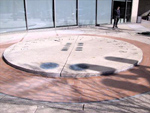 |
Calgary |
Alberta |
Canada |
Analemmatic Dial |
Dial 197 |
| Stone analemmatic dial designed by Kasian Kennedy. Dial is laid out in a circle. Monthly markers designate where observer is to stand to act as the gnomon. Both standard and saving time hour marks time from 5am to 8pm. |
| |
| |
|
Wooster |
Ohio |
USA |
Horizontal Dial |
Dial 196 |
| Brass or bronze Gift to the College from the Class of 1907. On S side of gnomon, an embossed figure, possibly Father Time with scythe. Mounted atop a carved stope base with motto, "United in time, parted in time to be reunited when time shall be no more." |
| |
| |
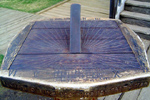 |
Edmonton |
Alberta |
Canada |
Horizontal Dial |
Dial 195 |
| A horizontal dial of varnished wooden shaped as octagon, perhaps 24 in. across, 2 in. thick, with very thick wedge-shaped gnomon. Roman numerals carved at ends of hour lines. Dial sat atop a segment of tree trunk. |
| |
| |
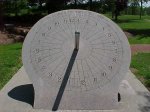 |
Frankenmuth |
Michigan |
USA |
Equatorial Dial |
Dial 194 |
| This monument sundial is an Erickson equatorial polar dial 6 feet in diameter made of light granite with a 3 inch steel rod as gnomon. Time is graduated by hour, half-hour, quarter hours and 5 minute marks over 24 hours. Noon is at the bottom, matching the 105 degree meridian. Designed to be read from the upper surface in Spring/Summer, from the under side in Fall/Winter. Unlike other Erickson dials, the Equation of Time plaque is presented in a circular arc on the ground. |
| |
| |
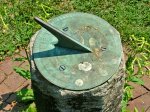 |
Fredericksburg |
Virginia |
USA |
Horizontal Dial |
Dial 193 |
| A 7 inch diameter brass horizontal dial with 3.5 inch high brass gnomon on a weathered octagonal stone pedestal. Reported to be contemporary with Mary Ball Washington's occupancy of this house in the 1780s. Dial sits atop a stone pillar. |
| |
| |
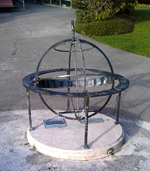 |
Arcata |
California |
USA |
Armillary Sphere |
Dial 192 |
| Armillary dial with horizon ring 4 ft. 4.5 in. diameter designed by Ken Lynch. Dial is made of brass and horizon ring has signs of the zodiac on it. Mounted at ground level with a separate plaque with Equation of Time. After the dial was installed the university ordered the point on the end of the gnomon sawed off. It was feared that someone might become impaled on it. Gift of Harvy S. Kieval, Professor Emeritus - Math. |
| |
| |
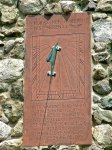 |
Waltham |
Massachusetts |
USA |
Vertical Dial |
Dial 191 |
| A declining vertical sandstone dial approximately 3x6 feet with bronze gnomon. Mounted at 2nd floor level on large stone house. Roman numerals. Hour lines from 6 am-5 pm are not in standard vertical position, presumably offset to correct for wall not facing due South. Dial reclines approx 2 degrees north. Dial # 190 (Cambridge MA, Mt. Aubry Cemetery, Story Chapel) has same Whittier inscription. |
| |
| |
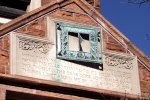 |
Cambridge |
Massachusetts |
USA |
Vertical Dial |
Dial 190 |
| Approx 2' x 2' Bronze Square bronze plate, with Roman numerals, is open in the center. Gnomon extends through this open space. Dial is mounted above a window of the chapel, angled from wall face. (presumably so that it will face true South.) |
| |
| |
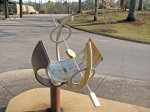 |
Tuscaloosa |
Alabama |
USA |
Equatorial Dial |
Dial 189 |
| A 5 foot bronze and steel equatorial dial with pinhole gnomon in front of the North River Yacht Club. |
| |
| |
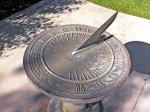 |
San Bernardino |
California |
USA |
Horizontal Dial |
Dial 188 |
| A 23 inch diameter horizontal bronze dial with 12 inch high gnomon and with hour, half-hour and quarter-hour lines from 5:30 AM to 7:30 PM and Roman hour numerals from 5 AM to 7 PM. Dial sits atop a 27 inch diameter stone pedestal 37.5 inch high. |
| |
| |
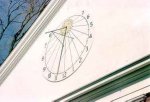 |
Mystic |
Connecticut |
USA |
Vertical Dial |
Dial 187 |
| Vertical 7 ft. diameter dial. Dial painted on circular piece of wood with Arabic numerals 6AM-7PM on wall declining 9:10 west. Mounted below peak of building. Smiling sun face at point where gnomon strikes dial plate. Designed by Albert Waugh and built by Edwin Pugsley. |
| |
| |
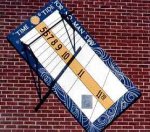 |
Mystic |
Connecticut |
USA |
Vertical Dial |
Dial 186 |
| Large slanted vertical dial on 8 ft. by 4 ft. wood rectangle mounted on a wall declining 80:50 east. Shows hours only till 11:30 AM, thus frequently called 'the morning dial'. Dial originally had no motto. Inscription was added later when dial was refurbished. Designed by Albert Waugh and fabricated by Edwin Pugsley. |
| |
| |
 |
River Falls |
Wisconsin |
USA |
Vertical Dial |
Dial 185 |
| The inspiration for this sundial, at one time the largest vertical dial in the world, came from Dr. Swensen visiting Heidelberg castle that had a large vertical dial on the wall of the castle. Construction of the Univ. of Wisconsin dial began in 1994 on the south wall of the Kleinpell Fine Arts Building. The result is a 30 x 56 foot vertical dial of anodized aluminum with analemmic hour markers, and day lines to mark winter and summer solstice, Candelmas (1/31), Martinmas (11/10), Beltane (5/8) and Lammas (8/4), vernal and autumnal equinoxes. The massive south-facing vertical dial takes up the entire wall of the three-story fine arts building. The hour markers are gold on the 'Spring' side and brown on the 'Fall' side with 7 day intervals marked on each. |
| |
| |
|
Schroon Lake |
New York |
USA |
Horizontal Dial |
Dial 184 |
| 7-sided metal plate, about 9.75" on a side. Bronze. Unusual 7-sided dial plate, Arabic numerals. Hour and half-hour marks on outside rim. Image of bible and cross on plate left of gnomon, and 'Word of Life' on right. (These are the standard logo of the organization.) Fabricated by Colonial Brass Co, Middleboro MA. |
| |
| |
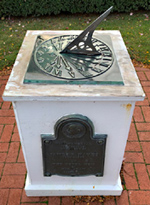 |
Mackinac |
Michigan |
USA |
Horizontal Dial |
Dial 183 |
| ca 16 in. square brass horizontal dial. Hours from 5am to 7pm in Roman numerals. Arrows radiate from the foot of the gnomon to each hour and three stars are located at the south end of the gnomon. The dial originally sat on a sightly tapered white concrete square pillar. When the dial was moved near the Jockey Club, the pedestal was redone in a square wood column painted white. A memorial plaque original on the south side of the pedestal is now on the east side. The dial was erected in memory of James R. Hayes, manager of The Grand Hotel from 1890 to 1900. The dial now sits in a small brick plaza. |
| |
| |
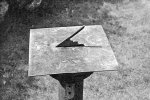 |
Burlington |
Vermont |
USA |
Horizontal Dial |
Dial 182 |
| Approximately 16 inch square metal horizontal dial with engraved dial face. Photo taken approximately 1965. Dial may have been removed. May required admission to Shelburne Museum. |
| |
| |
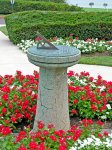 |
Annapolis |
Maryland |
USA |
Horizontal Dial |
Dial 181 |
| Farenholt sundial for U.S. Naval Hospital Annapolis MD. This cast bronze dial was designed and commissioned by RADM Farenholt for U.S. Naval Hospitals at bases where he was commanding officer, visited, or had special meaning to him. The dial is 18 inches (46cm) in diameter. The outer chapter ring has the motto, followed by a chapter ring with Arabic hours 6am to 6pm, raised hour lines that radiate from near the foot of the gnomon and short half-hour lines. The gnomon has graceful curves and a trefoil or quatrefoil cut-out in the center. Below the gnomon is the naval command name, followed by the commissioning date in the southern portion of the hours chapter ring. |
| |
| |
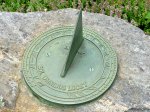 |
Sturbridge |
Massachusetts |
USA |
Horizontal Dial |
Dial 180 |
| A 1 foot diameter cast iron circular plate, with Roman numerals 5 am to 7 pm. Subdivided into 30 min increments on one ring, 10 minute increments on an adjacent one. Fastened with screws to a large rock. Reproduction of an authentic original cast iron dial from the Samuel Pierce House, Middleton, CT. Plaque reads "In grateful recognition for the leadership and service of Edward L. Clifford, Chairman of the Board of Trustees." |
| |
| |
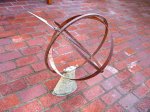 |
Carmel |
California |
USA |
Equatorial Dial |
Dial 179 |
| A simple 12 inch diameter equatorial ring dial of rusted steel on a cast iron base bolted to a brick floor. This replacement dial has Arabic numerals and the base has Zodiacal symbols. The original "Sundial Lodge" was renovated as a boutique hotel but during the construction the original horizontal dial was lost.
The original horizontal dial was about 16 in. diameter, made of bronze with a circular plate with Roman numerals on a plain concrete column and displayed the inscription, "Count none but the sunny hours." |
| |
| |
|
Bristol |
Connecticut |
USA |
Horizontal Dial |
Dial 178 |
| Horizontal dial designed by Richard R. Bolster. Stone. "Mr. Bolster couldn't find dials to collect so he made his own collection." |
| |
| |
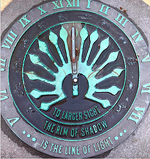 |
South Hadley |
Massachusetts |
USA |
Horizontal Dial |
Dial 177 |
| ca 18 inch diameter horizontal dial. Roman numerals, 5 AM to 7 PM. Zodiac signs in circle within numerals. Capricorn and Sagittarius misplaced. The gnomon was replaced in 1991, but again has been vandalized. Dial sits atop a granite 4-finned pillar with circular granite capital. |
| |
| |
 |
Woods Hole |
Massachusetts |
USA |
Pillar Dial |
Dial 176 |
| Stone pillar. Brass EOT graph Four-sided column. Dial on each face, with stone sphere containing a polar axis mounted on the top. Known as the Yalden dial. North gnomon has been placed incorrectly since at least the early 70's. |
| |
| |
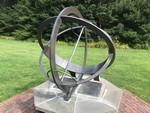 |
Sandwich |
Massachusetts |
USA |
Armillary Sphere |
Dial 175 |
| Bronze armillary dial about 40 inches in diameter, weighing between 1100-1200 pounds. The dial has wide 4 inch meridian and equatorial rings. The equatorial ring is flanked with small arctic and antarctic circles near the poles. The gnomon is a brass rod 1 inch in diameter. According to Heritage Museum, "Originally the sundial was highly polished and the engravings on the dial and the instruction plaques were all filled with red paint to make it easier to read. The piece has acquired a patina now and traces of the red paint are still visible." The dial is corrected for longitude and along one side of the octagonal stone pedestal is a graph of the equation of time with instructions on how to read corrected time from the dial. |
| |
| |
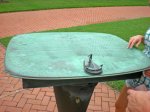 |
Annapolis |
Maryland |
USA |
Obelisk or Vertical Gnomon |
Dial 174 |
| 4'x4' Bronze & Brass 4' Dial plate is elaborately engraved bronze with hour and date lines. Self-orienting dial. Locate line for the date; rotate dial until shadow tip touches that line. Read time from intersection of the shadow's tip and the time line radiating from dial center. Gnomon is a model of a naval missile, resting on an anchor. A ship's binnacle supports rotating sundial plate. |
| |
| |
|
Richmond |
Virginia |
USA |
Obelisk or Vertical Gnomon |
Dial 173 |
| 'Built in 1981 after an article in Scientific American (Dec 1980 "The Amateur Scientist") described a computer program for building a gnomonic dial with analemma hour lines. The dial was painted on the museum's parking lot, using a ball atop a 25 ft aluminum flagpole as the nodus. Semi-annual analemmas were painted in different colors, allowing correction for the equation of time. The dial was refurbished June 1992. |
| |
| |
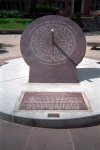 |
Boulder |
Colorado |
USA |
Equatorial Dial |
Dial 172 |
| A large polar equatorial dial by Erickson Monuments, known as the "Tippit Sundial" given by John Tippit in memory of his son. The dial is of dark red granite, 6 feet in diameter and 6.375 inches thick. The gnomon shaft is steel, extending from the ground through the dial plate and outward another two feet. 24 hours are inscribed on each side of the dial (summer and winter) as radiating lines with Arabic numbers at the end. Time is graduated by half-hour and 5 minute marks. Designed to be read from the upper surface in Spring/Summer, from the under side in Fall/Winter. The hours on the under side of the dial were originally engraved backwards. Two plaques provide the Equation of Time to convert solar time to watch time. The dial rests on a cement work 7 feet high. |
| |
| |
|
Napanee |
Ontario |
Canada |
Armillary Sphere |
Dial 171 |
| 4 ft Steel Sphere. Gnomon frame and dial frame made of 6 in. x 4 ft. steel wagon tires. Gnomon is 6 in. diameter steel rod. Mounted on base using standard pipe fittings. Dial sits atop a 2.5 inch diameter pipe. |
| |
| |
|
Mount Laguna |
California |
USA |
Equatorial Dial |
Dial 170 |
| The odd bowl-shape of this equatorial dial designed and built by C.T. and W.M Thwaites shows a reversed engraved map of the world. A horizontal bar across the bowl has a small metal nib which points out the time of the day (top and bottom for standard and daylight times) and also indicates the spot on the world where the Sun is currently directly overhead. On full Moon nights, this dial has been used to effectively tell time and show the position of the Moon over the Earth as well. |
| |
| |
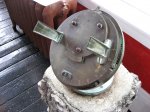 |
Saint Anthony |
Newfoundland |
Canada |
Heliochronometer |
Dial 169 |
| A Pilkington & Gibbs Heliochronometer, 9 in. diameter, 9 in. high bronze with two sights, 3 x 1.5 in. Points of compass on dial base, months and dates on face. Rotates to compensate for EOT. Dial is a circular plate, mounted to allow adjustment for latitude. Gnomon consists of two cast posts with vertical slits, about 6 in. high, on opposite sides of plate. Another adjustable scale permits EOT corrections. It was part of original house from 1909-1939. Not dated, but the chronometers were sold between 1907-1914. Now on display in museum and not set up for use. Heavily patinated with some corrosion. Fabricated by Pilkington & Gibbs Ltd, Preston England, # 433. The dial is mounted to a solid Labradorite pillar, 1 foot square, 21 inch high. |
| |
| |
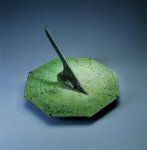 |
Mt. Vernon |
Virginia |
USA |
Horizontal Dial |
Dial 167 |
| A bronze octagonal horizontal dial about 12 inches on a side. Original dial is badly worn and virtually illegible; this original is now stored inside the museum. A 6 inch replica of the dial is located on a pedestal in the center of a circular lawn. This replica has an 8-pointed compass rose in the center and Roman numerals from 5 AM to 7 PM. The hour intervals are graduated into two-minute increments, with Arabic numerals 20-40-60 at appropriate places between the hour lines. Pictures of both the replica and the original dial are in the Image Archive. |
| |
| |
|
Knoxville |
Tennessee |
USA |
Horizontal Dial |
Dial 166 |
| 78" w x 168" h x 78" d Steel, brass & etched glass As the sun penetrates the building a shadow is cast from the gnomon onto the 1 inch thick laminated glass which has hour lines etched into its surface. The time is viewed from the underside of the dial. A deep carved mountain landscape is artificially lighted in the lower section. |
| |